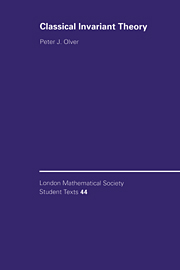Book contents
- Frontmatter
- Contents
- Introduction
- 1 Prelude — Quadratic Polynomials and Quadratic Forms
- 2 Basic Invariant Theory for Binary Forms
- 3 Groups and Transformations
- 4 Representations and Invariants
- 5 Transvectants
- 6 Symbolic Methods
- 7 Graphical Methods
- 8 Lie Groups and Moving Frames
- 9 Infinitesimal Methods
- 10 Multivariate Polynomials
- References
- Author Index
- Subiect Index
1 - Prelude — Quadratic Polynomials and Quadratic Forms
Published online by Cambridge University Press: 08 January 2010
- Frontmatter
- Contents
- Introduction
- 1 Prelude — Quadratic Polynomials and Quadratic Forms
- 2 Basic Invariant Theory for Binary Forms
- 3 Groups and Transformations
- 4 Representations and Invariants
- 5 Transvectants
- 6 Symbolic Methods
- 7 Graphical Methods
- 8 Lie Groups and Moving Frames
- 9 Infinitesimal Methods
- 10 Multivariate Polynomials
- References
- Author Index
- Subiect Index
Summary
Classical invariant theory is the study of the intrinsic properties of polynomials. By “intrinsic”, we mean those properties which are unaffected by a change of variables and are hence purely geometric, untied to the explicit coordinate system in use at the time. Thus, properties such as factorizability and multiplicities of roots, as well as their geometrical configurations, are intrinsic, whereas the explicit values of the roots and the particular coefficients of the polynomial are not. The study of invariants is closely tied to the problem of equivalence — when can one polynomial be transformed into another by a suitable change of coordinates — and the associated canonical form problem — to find a system of coordinates in which the polynomial takes on a particularly simple form. The solution to these intimately related problems, and much more, are governed by the invariants, and so the first goal of classical invariant theory is to determine the fundamental invariants. With a sufficient number of invariants in hand, one can effectively solve the equivalence, and canonical form problems, and, at least in principle, completely characterize the underlying geometry of a given polynomial.
All of these issues are already apparent in the very simplest example — that of a quadratic polynomial in a single variable. This case served as the original catalyst for Boole and Cayley's pioneering work in the subject, and can be effectively used as a simple (i.e., just high school algebra is required) concrete example that will motivate our study of the subject. We shall devote this introductory chapter to the elementary theory of quadratic polynomials in a single variable, together with homogeneous quadratic forms in two variables.
- Type
- Chapter
- Information
- Classical Invariant Theory , pp. 1 - 10Publisher: Cambridge University PressPrint publication year: 1999



